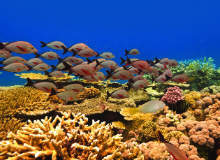With some of the most treasured marine habitats on the planet, Australia has realised that its offshore environment cannot be managed in isolation from its E&P activity. Jane Cutler, CEO of NOPSEMA, explains how a holistic approach will continue to pay dividends for the oil and gas industry without disrupting the country’s delicate ecological balance.

Visible from space, the Great Barrier Reef is one of the natural wonders of the world. Treasured by scientists for its unparalleled biodiversity and visited by tourists from all four corners of the Earth, it is undeniably one of Australia’s most important assets. But just around the coast, the Montara well blow-out in 2009 showed just what potential there was for damage to Australian waters. Oil leaked for 74 days into the Timor Sea before being successfully plugged by pumping mud into a relief well, but not before up to 30,000t of oil had entered the ocean.
The body responsible for the safety of offshore oil and gas operations at the time was the National Offshore Petroleum Safety Authority (NOPSA), which had no powers and no remit to influence the environmental impact of the industry.
Following a comprehensive review of the accident, NOPSA became the National Offshore Petroleum Safety and Environmental Management Authority (NOPSEMA) on 1 January 2012. Now responsible for the safety of offshore workers and the natural environment in which they work, the authority’s expanded remit should allow for the country’s E&P activities to expand without having an adverse impact on the environment, as NOPSEMA CEO Jane Cutler explains to Mark Brierley.
Mark Brierley: Why was the decision taken to expand the remit of NOPSA to include environmental management and become NOPSEMA? How were environmental management practices monitored before this?
Jane Cutler: The establishment of NOPSEMA follows recommendations in the Final Government Response to the Report of the Montara Commission of Inquiry (2011) and the Productivity Commission Report (2009), and was initiated by Minister for Resources, Energy and Tourism Martin Ferguson to promote a unified approach to offshore industry regulation across the key areas of safety, well integrity and environment. Prior to the establishment of NOPSEMA, under commonwealth legislation the relevant state and territory governments had responsibility for environmental management regulation.
Australia is home to some of the world’s most delicate marine environments. What unique challenges do these represent for you as regulator?
Australians have high expectations that a viable and growing national offshore petroleum industry will also be a safe one. The reality is that offshore oil and gas production is a high-hazard undertaking and it’s up to the industry to minimise those risks by being vigilant in its commitment to the safety of people and the marine environment.
NOPSEMA approaches its functions and responsibilities with a view to meeting world-class standards in risk mitigation and environmental management. Strong safety and environmental management performance is fundamental to restoring confidence in an industry that has seen major disasters. The challenge rests in functioning as an independent regulator that requires operators to be responsible for developing plans applicable to their particular operating environment.
What role do operators play in the development of environmental management regimes? Is it the case that NOPSEMA imposes the standards, or are they mutually agreed between the two parties?
NOPSEMA has begun assessment of environment plan submissions from operators of petroleum activities, where the operator/titleholder must demonstrate how they intend to mitigate the environmental risks posed by their petroleum activity to a level that is ‘as low as reasonably practicable’ (a term recognised within industry as ALARP).
In each case, NOSPEMA will make a judgement based on the evidence the operator provides as part of its environment plan submission, and will assess the operator’s management systems, oil spill contingency plans and baseline data, which it will use to make its decision on whether the operator is able to proceed with the activity.
The regulator must ultimately refuse to accept the plan if it does not adequately address the risks associated with the activity, and it is an offence under the environment regulations for an operator to proceed with a petroleum activity without an accepted environment plan. Following acceptance of an environment plan, the next step is for NOPSEMA to conduct regular inspections of the petroleum activities to verify that operators are abiding by their own safety and environmental management processes as outlined in their submissions to NOPSEMA. If these processes are not being followed, NOPSEMA has powers to instigate enforcement action up to and including the revocation of approvals.
With large areas of Australia’s coastline sparsely populated, how does this affect preparedness and response times in the event of an industry-related accident?
It is the responsibility of the operator to demonstrate and develop incident response measures and capacity, particular to their circumstances, including plans for remote and sparsely populated areas.
Without an adequate demonstration of capacity, the submitted environment plan will not be accepted and the operator would not be able to operate. Response times and preparedness factors would therefore differ across locations.
Given Australia’s rising E&P activity, is current legislation adequate to cope or do you think legislation will need to evolve in the future?
The advantage of an objectives-based, over a prescriptive, regime is that it ensures the operator has appropriate environmental management plans regardless of the nature of the activity or where it is taking place. The regime allows for flexibility in the amount of E&P activity taking place in the jurisdiction. It also means the potential for cumulative impacts of such activities can also be taken into account by operators.
